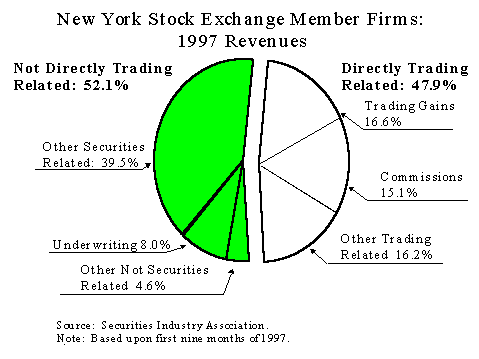
Figure 6
In the February 1997 New York State Economic and Revenue Report 1996-97 & 1997-98, we explained that the strength of the stock market in recent years has been caused by the vitality of the national economy and the stability of short-term interest rates. We also described a number of demographic and economic factors which are likely to increase the demand for stocks, and therefore produce continued strength in the stock market over the long-term. These factors include:
Three consecutive years of spectacular stock market growth have helped create a very profitable environment for Wall Street firms. Profits in the securities industry appear to have topped $12 billion in 1997, representing growth of almost 10 percent compared to 1996. Hence, there is every reason to believe that industry employees earned record breaking levels of bonus income in late 1997 and early 1998, well exceeding that for the same period last year.
The Vitality of the Mergers and Acquisitions Business
The stock market’s strength has not been the only reason for Wall Street firms’ strong performance. In fact, only about half of 1997 New York Stock Exchange member firm revenues have come from activities directly related to stock trading, such as trading gains, commissions, or commodities trading (see Figure 6).

Figure 6
A breakdown of firm revenues reflects explosive growth in the underwriting
of corporate equities and debt in 1997. The total volume of corporate underwriting
in the United States reached $1.3 trillion, exceeding the volume of any
previous year. This record-setting pace was driven by the issuance of corporate
debt, which in 1997 topped $1 trillion in value for the first time.6
6. Securities Industry Association, Securities Industry
Trends, Vol. 24, No. 1, January 23, 1998.
One of the most lucrative of Wall Street activities is the management
and underwriting of corporate mergers and acquisitions. Mergers and acquisitions
should continue to be an important source of Wall Street profits for the
foreseeable future. In 1997, the volume of announced mergers and acquisition
transactions reached $917.7 billion, exceeding the 1996 total by 46.5 percent
and more than doubling the value of deals completed in 1995.7
The top ten deals through November are listed on Table 1. The mix of industries
affected by 1997’s buying wave was quite diverse, including telecommunications,
commercial banking, securities, hotels and casinos, electric and gas utilities,
broadcasting, health care services, real estate trusts, and others.
7. Merger and acquisition activity produces profits for
firms beyond the finance community. For example, while New York Stock Exchange
member firms earned $1.4 billion in fees from this activity, an additional
$918 million was earned in legal fees. Judy Randler Cohen, Brian Garrity,
and Scott Stuart. "The Year of Big Deals," Investment Dealer's Digest,
January 19, 1998.
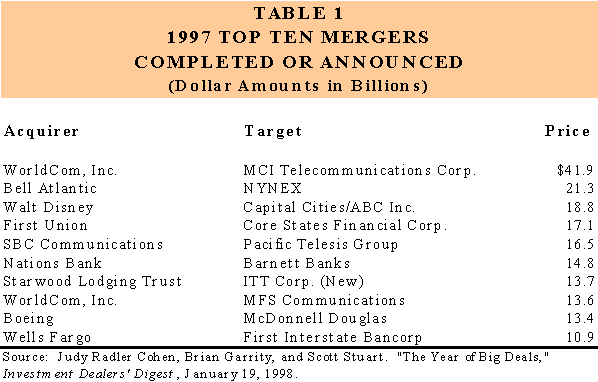
Although the proliferation of mergers and acquisitions may be related to the general level of the stock market, there are many additional factors spurring the current wave of activity as firms continue to respond to the competitive pressures of a more global economy. Mergers are playing an increasingly important role in corporate restructuring. This contrasts with the late 1980’s and early 1990’s, when corporate restructuring was primarily a process internal to the corporation, with an emphasis upon downsizing. However, since this initial period, internal restructuring has approached the limit of its effectiveness in many industries. Corporate restructuring has recently taken on a more external character, with mergers and acquisitions becoming a key element.
Increasing globalization has also encouraged firms to consider strategic cross-border mergers and acquisitions, as companies seek to improve their positions in the global market. Some of the industries most active in mergers and acquisitions in the U.S. health care, financial services, telecommunications, and utilities, have also dominated the European market. Cross-border mergers and acquisitions action in Europe reached a volume of $114 billion in 1996, a 122 percent increase over the 1993 level. In addition, the extension of the North American Free Trade Agreement to areas south of Mexico could encourage more mergers and acquisitions activity as American companies look to merge with firms located south of the border.
The rapid pace of technological change is another factor spurring the pace of merger and acquisition activity. Although large firms have traditionally relied primarily on their own innovations, internal research and development can be too slow and expensive to help companies maintain their competitive edge. A firm might gain immediate access to a desired technology by acquiring another firm. Similarly, two firms can gain by merging and consolidating their research departments.
Changes in the regulatory environment have also encouraged robust growth in the mergers and acquisitions market. In recent years, the U.S. Justice Department has tended to approve deals that it would have prevented a few years ago, preferring to add conditions to the deals, rather than stop them. Congress has spurred mergers and acquisitions activity by approving deregulation of the telecommunications industry and considering deregulation of the electric industry. In addition, Congress has considered repealing the Glass-Steagall Act, provisions of which are intended to prohibit banks from entering the securities trading and underwriting business.
Collectively, the above factors should continue to exert their influence through 1998. Indeed, industry experts are not anticipating a significant decline in merger and acquisition activity for the next few years. Thus the mergers and acquisitions business can be expected to contribute to a healthy year on Wall Street, even in the event of slower growth in the securities market.
9. Jon Birger, "Wall St. Bonus Pay to Reach New Highs," Crains, October 13-19, 1997.
As we reported last year, bonus income has become an increasingly widespread
form of employee compensation.10 Hence, an accurate
estimate of total bonus income is essential for correctly forecasting State
revenue growth. Although bonus income is earned in many industries, it
is still largely concentrated in the finance, insurance, and real estate
(FIRE) sector and within the securities industry, in particular. However,
preliminary estimates indicate that 1996-97 bonuses were even higher than
predicted. Based on the most reliable data available, bonus income for
the last quarter of 1996 and the first quarter of 1997 is estimated to
total $10.7 billion and $10.1 billion, respectively. This represnts total
bonus income for the 1996-97 season of $20.8 billion (see Figure 7).
10. For a more detailed discussion and a description
of the forecast methodology employed, please see NYS Assembly Ways and
Means Committee, New York State Economic and Revenue Report 1996-97 &
1997-98, March 1997.
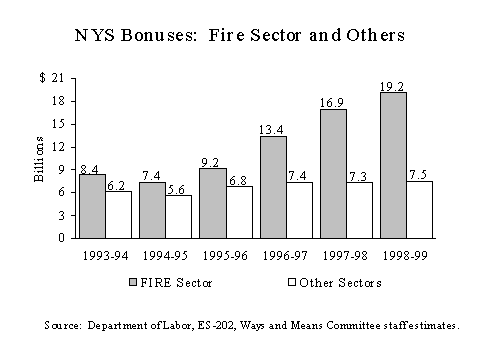
Figure 7
During the 1996-97 bonus season, total State wages and salaries grew by $16.6 billion over 1995-96. Although bonuses accounted for seven percent of total wages and salaries in 1996-97, they accounted for fully 18 percent of the growth. During this same period, FIRE sector bonuses grew by 45.7 percent over the same period one year prior. Securities industry bonuses alone grew at an even faster rate of 60.8 percent. This contrasts with employment growth of 3.4 percent in the securities industry over the same period.
What does this growth in bonus income mean for total personal income growth for New York State? The growth in bonus income earned in 1996-97 over 1995-96 is estimated to have contributed an additional $4.8 billion to New York personal income. The FIRE sector alone accounted about $4.2 billion of this added income (about 90 percent of the total), of which the securities industry accounted for about $4.0 billion, or about 80 percent of total New York bonus income.
The Committee staff predicts bonus income growth for the 1997-98 season of 16.5 percent, compared to 30.0 percent for 1996-97. The Committee staff predicts New York personal income will grow 5.3 percent in 1998, following growth of 5.8 percent in 1997. The largest component of personal income, wages and salaries, is predicted to grow 5.7 percent in 1998, following growth of 6.6 percent in 1997. The Committee staff predicts growth of 10.2 percent for the 1998-99 bonus season.
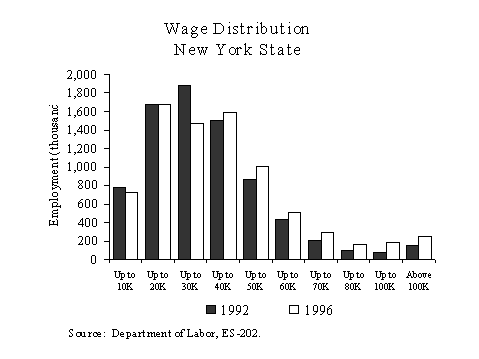
Figure 8 illustrates the shift in the distribution of state wages between 1992 and 1996. The increase in the number of workers in the uppermost income category is undoubtedly related to the last three years of strong financial market growth. The decline in the number of workers in the $20,000 - $30,000 income group is likely a result of corporate restructuring. The overall rightward shift in the distribution is evidence of the overall improvement of State wages, as the State economy enjoys the benefits of a long national expansion. The impact of these trends has varied significantly by industry group.
Consider the health care industry group, where the average annual wage
increased from $30,268 in 1992 to $33,719 in 1996, an increase of 11.4
percent. However, behind this rise in the average wage lies a substantial
shift in the distribution of income. Wage increases are easily visible
in Figure 9 among employees earning $30,000 and above. However, we can
also observe the impact of downsizing in the industry, resulting in the
removal from the payrolls of a substantial number of employees earning
less than $30,000. In 1996, health care industry group employment fell
by 0.2 percent. All of this decline can be attributed to downsizing among
hospitals. This reduction continued into 1997, with the loss of almost
14,000 hospital sector jobs during the first two quarters of 1997, compared
to the same period in 1996.
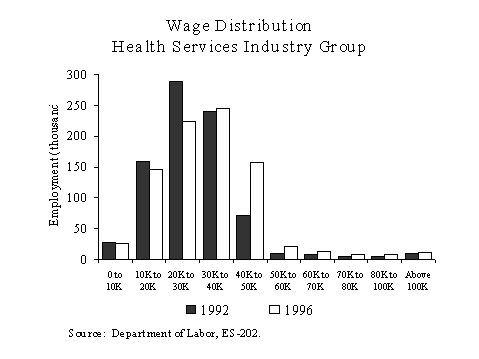
Figure 9
The finance, insurance, and real estate (FIRE) sector has also experienced
a substantial degree of downsizing during the recent period. However, the
distribution of income in this sector looks much different from that of
the health care industry group. The FIRE sector is the highest-paying industrial
sector in the State. The average annual wage grew from $57,332 in 1992
to $73,100 in 1996, an increase of 27.5 percent over the period. However,
Figure 10 suggests that much of this increase in the average wage is accounted
for by those workers entering the $100,000 and above range, where the number
of employees rose dramatically from 100,000 to 156,400. Much of this increase
occurred in the securities and commodities brokers industry. Moreover,
while the average wage in the securities industry was making great leaps,
FIRE was downsizing employees at the lower end of the wage spectrum, particularly
within the commercial banking and insurance industries, resulting in a
rightward shift in the wage distribution. Forms of employee remuneration,
such as bonus pay for workers already on the upper part of the industry
wage-scale, make the wage structure within the FIRE sector much different
from that of any other industry group.
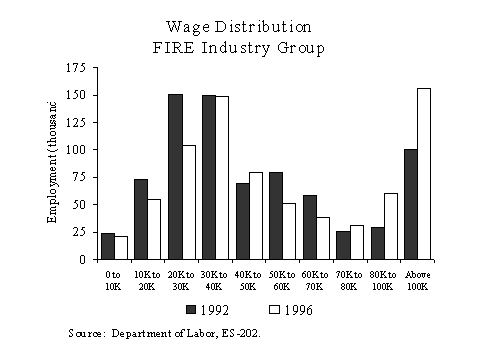
Figure 10
The distribution of wages within the business and professional services
industry group (see Figure 11) stands in contrast to those of both the
FIRE and health care industries. The strength of the national expansion
has been a boon to the fortunes of the business and professional services
industry group. The average wage for the industry group grew 13.7 percent
over the period from $35,182 in 1992 to $39,961 in 1996. However, unlike
the two industry groups discussed above, this increase in wages did not
result in a substantial shift in the wage distribution. This indicates
that the rise in the average wage has been the result of wage increases
across the board, and not downsizing on the lower end of the wage-scale.
There was substantial improvement within the upper income categories, but
nothing like what was observed in the FIRE sector.
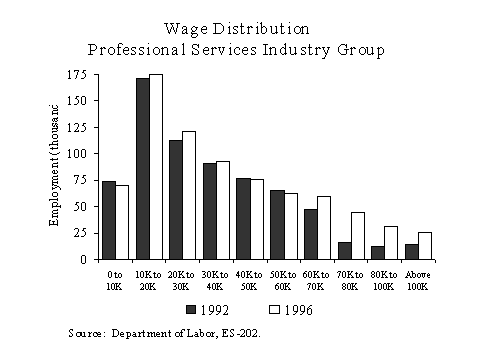
Figure 11
Behind the employment statistics for the nation overall, there exist diverse regional patterns, with certain regions of the nation exhibiting much stronger growth than others (see Table 3). Weakness in the manufacturing sector was a common feature among most of the states in the New England, Middle Atlantic, South Atlantic, and East South Central regions. The Mountain region was the only one where every state experienced job gains in the manufacturing sector. The states of the West North Central and Mountain regions exhibited the strongest industrial growth rates in the nation.
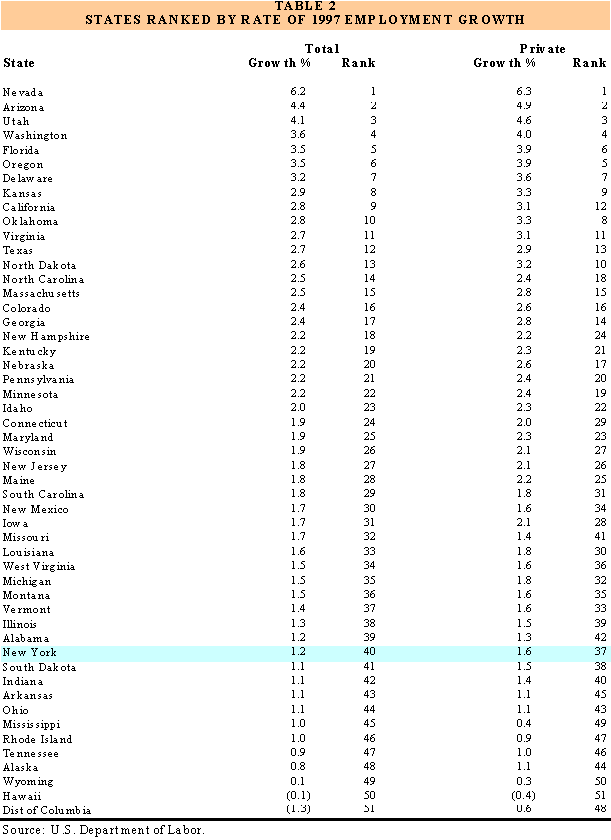
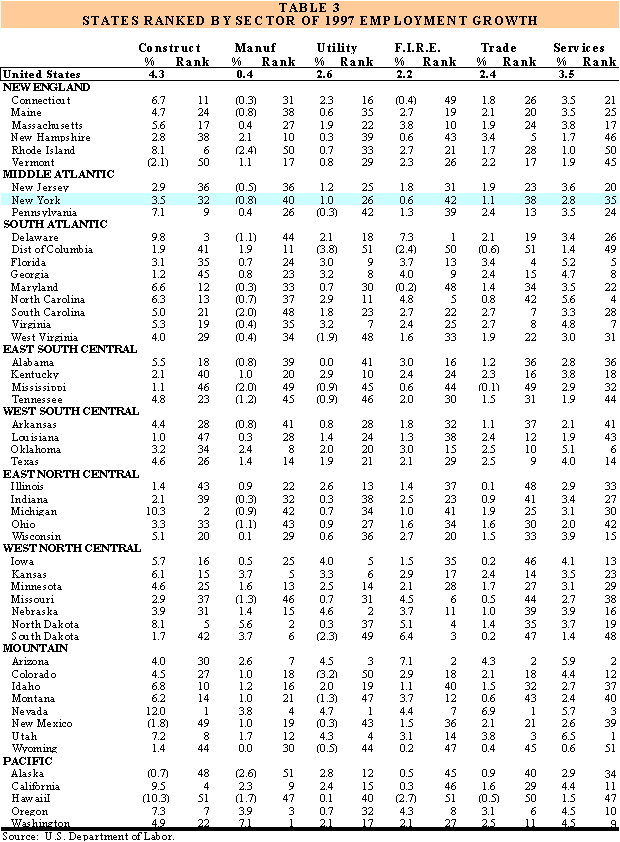
The most recent recession was much deeper and more severe for New York than for most of the rest of the nation. The national recession is officially recorded as ending during March of 1991. However, the State recession is estimated to have ended in December 1992. Since then, State employment growth has consistently lagged behind the national average. Even with the State in its sixth year of expansion, this continues to be the case. As indicated in the third column of Table 2, during 1997, State employment grew 1.2 percent on an average annual basis, about half of the 2.3 percent growth experienced nationwide. New York’s rate of overall job growth placed the State 40th among the 50 states and the District of Columbia (see Table 2), well behind California, Texas, Florida and Pennsylvania. The State ranked 37th in private sector job growth.
New York is lagging in virtually every sector of the economy. In terms of rates of job growth, the State ranked consistently in the bottom 20 in every sector with the exception of the utility sector. New York lags behind, even when compared to eight neighboring states in the Middle Atlantic and New England regions.
In the nationally booming construction sector, New York ranked 32nd in the nation, but even among its neighbors in the Northeast it had the fourth lowest growth rate of 3.5 percent. Declining by 0.8 percent, the State’s manufacturing sector ranked New York 40th in the nation, and second from the bottom among its neighboring states. In the rapidly changing utilities industry New York ranked 26th in the nation and fourth among its neighboring states, with growth of 1.0 percent. Weak FIRE sector employment growth of 0.6 percent placed New York behind all but six states in the nation and behind all but one state in the Northeast region. New York also registered the slowest growth rate among its neighboring states in the trade industry, with growth of 1.1 percent.
New York’s fastest growing sector is services, which added about 73,000 jobs in 1997. The State showed particular strength in two high-wage industries – business services, which grew 6.4 percent, and engineering and management services, which grew 5.0 percent. However, with an overall rate of service sector growth of only 2.8 percent, New York managed to rank only 35th in the nation, outdoing only three of its neighboring states in the Northeast. The states adding the most services sector jobs were California, Florida, and Texas, while the states posting fastest rates of growth were Utah, Arizona, and Nevada.
The Committee staff is predicting State employment growth of 1.2 percent
for 1998, following growth of 1.2 percent in 1997. These rates of job creation
represent the strongest job growth since the end of the recession and provide
evidence that the strength of the national expansion is having a stimulating
impact on the State economy. Nevertheless, the State’s rate of job growth
is meager not only when compared to the rest of the nation, but also in
comparison to its own recent history. During the State’s 1980’s expansion,
which lasted from January 1983 to May 1988, the average annual rate of
employment growth was 2.1 percent.12 During that period,
the State economy produced a net increase of 90,610 jobs per year. In contrast,
the current State expansion, which began in December 1992, has produced
an annual average of 28,900 jobs, for an average annual growth rate of
only 0.5 percent.
12. See New York State Assembly Ways and Means Committee,
"A New Composite Index of Current Economic Activity for the New York State
Economy" 1995.